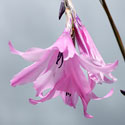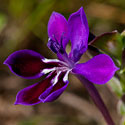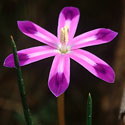Aristea
About 52 species, mainly southern African but
the distribution of this genus extends to Senegal and Ethiopia, and there
are seven species on Madagascar. Forty-six species are native to southern
Africa. |
 |
Babiana
Endemic to southern Africa. Most of the 91 species
are endemic to the Western Cape and Namaqualand (Northern Cape). |
 |
Bobartia
Fifteen species, endemic to the Western and Eastern
Cape, found mainly in montane rocky sandstone soils and particularly prevalent
after fires. |
 |
Chasmanthe
Three species, endemic to the Western
Cape and Eastern Cape, occurring usually in bushy places or on forest margins.
Closely related to the genus Crocosmia. |
 |
Crocosmia
Seven species, native to southern and eastern Africa as
well as Madagascar (one species). |
 |
Devia
Contains
a single species, Devia xeromorpha, found on the Roggeveld
Escarpment in the western karoo on clay soils in mountain
renosterveld. |
|
Dierama
The 44 species are found mainly in the summer rainfall
region of eastern southern Africa, but the overall distribution extends from
Knysna in the Western Cape, South Africa, to Ethiopia. Thirty-nine species
are native to southern Africa. |
 |
Dietes
Has a strange distribution with five species native to
southern Africa (one of which has a distribution extending into East Africa) and
one
species found on Lord Howe Island (east of Australia). The species found on Lord
Howe Island is Dietes robinsoniana and is closely related to Dietes
bicolor, found in the Eastern Cape. These two species have primitive
characters for the genus (Goldblatt & Manning 2000). |
 |
Duthieastrum
The
only species in this genus is Duthieastrum linifolium, found in the northern Karoo (Northern Cape). |
|
Ferraria
Total of 13 species, all native to southern Africa, distribution extending to
south tropical Africa. Most species are found along the west coast of South
Africa (Western and Northern Cape), mainly in sandy soils. |
 |
Freesia
Eighteen species, 16 of which are native to southern Africa (mainly to the
winter-rainfall region). The remaining two species are found in south
tropical Africa, one of which has a distribution extending as far north as Sudan. |
 |
Geissorhiza
The 100 species are endemic to South Africa,
found mainly in the Western Cape but also in Northern and Eastern Cape. |
 |
Gladiolus
About 260 species, with a distribution extending from South
Africa, through tropical Africa and Madagascar to Europe and the Middle East.
About 178 species are found in southern Africa, mainly in the Western Cape and
eastern highlands. |
 |
Hesperantha
About 82 species, found from the Western Cape to Ethiopia,
with centres of diversity in the southwestern Cape, western Karoo and the
Drakensberg. |
 |
Ixia
Endemic to Western Cape, Northern Cape and Eastern
Cape, with 69 species present. |
 |
Klattia
The
three species are endemic to the Western Cape. |
|
Lapeirousia
Occurs from Nigeria and Ethiopia through to the Western
Cape in South Africa. Of the 40 species, 38 are found in southern Africa. The
greatest diversity is in the semi-arid habitats of the Northern Cape
(Namaqualand and western karoo). |
 |
Melasphaerula
One
species, Melasphaerula ramosa, found from southern Namibia to the
Western Cape. |
 |
Micranthus
Three species, found in the Western Cape, usually in damp situations on
sandstone soils. |
 |
Moraea
About 200 species, found throughout
sub-Saharan Africa and with two species also occurring in the Mediterranean region
and the Middle East. A total of 184 species are native to southern Africa, with a
concentration of species in the Western Cape. |
 |
Nivenia
The
10 species are endemic to the Western Cape. |
 |
Pillansia
One
species, Pillansia templemannii, occurring from Kogelberg to
Kleinrivier Mountains in the Caledon district of the Western Cape. |
 |
Radinosiphon
Two species, found in mountainous areas from Mpumalanga and
Swaziland through to southern Tanzania. The pink, long-tubed flowers are
pollinated by the long-proboscid fly Prosoeca ganglbaueri (Nemestrinidae). |
 |
Romulea
About 88 species (79 in southern Africa,
especially diverse in winter rainfall area), found from southern Africa through
to Europe, Middle East and Canary Islands. |
 |
Sparaxis
The 15 species are endemic to the Western and Northern Cape, found
mainly on clay soils in renosterveld and to a lesser extent in coastal
sandveld. |
 |
Syringodea
The
eight species are found in the Northern and Western Cape, mainly on clay soils
in karoo vegetation. |
 |
Thereianthus
The
seven species are endemic to the Western Cape. |
 |
Tritonia
Occurs
from South Africa through to Tanzania but most of the 27 species are found
in the winter rainfall region of the Western Cape and Namaqualand
(Northern Cape). |
 |
Tritoniopsis
The 24 species are endemic to the Western Cape and Eastern
Cape, mainly on sandstone soils in fynbos. |
 |
Watsonia
The
52 species are endemic to southern Africa, with most species found in the
Western Cape and the grasslands of KwaZulu-Natal, Swaziland and
Mpumalanga. |
 |
Witsenia
The
only species in this genus, Witsenia maura, is in low-lying, peaty,
sandstone soils in the Western Cape, from the Cape Peninsula to
Swellendam. |
 |
Xenoscapa
The
two species are found from southern Namibia to Western Cape. |
|
